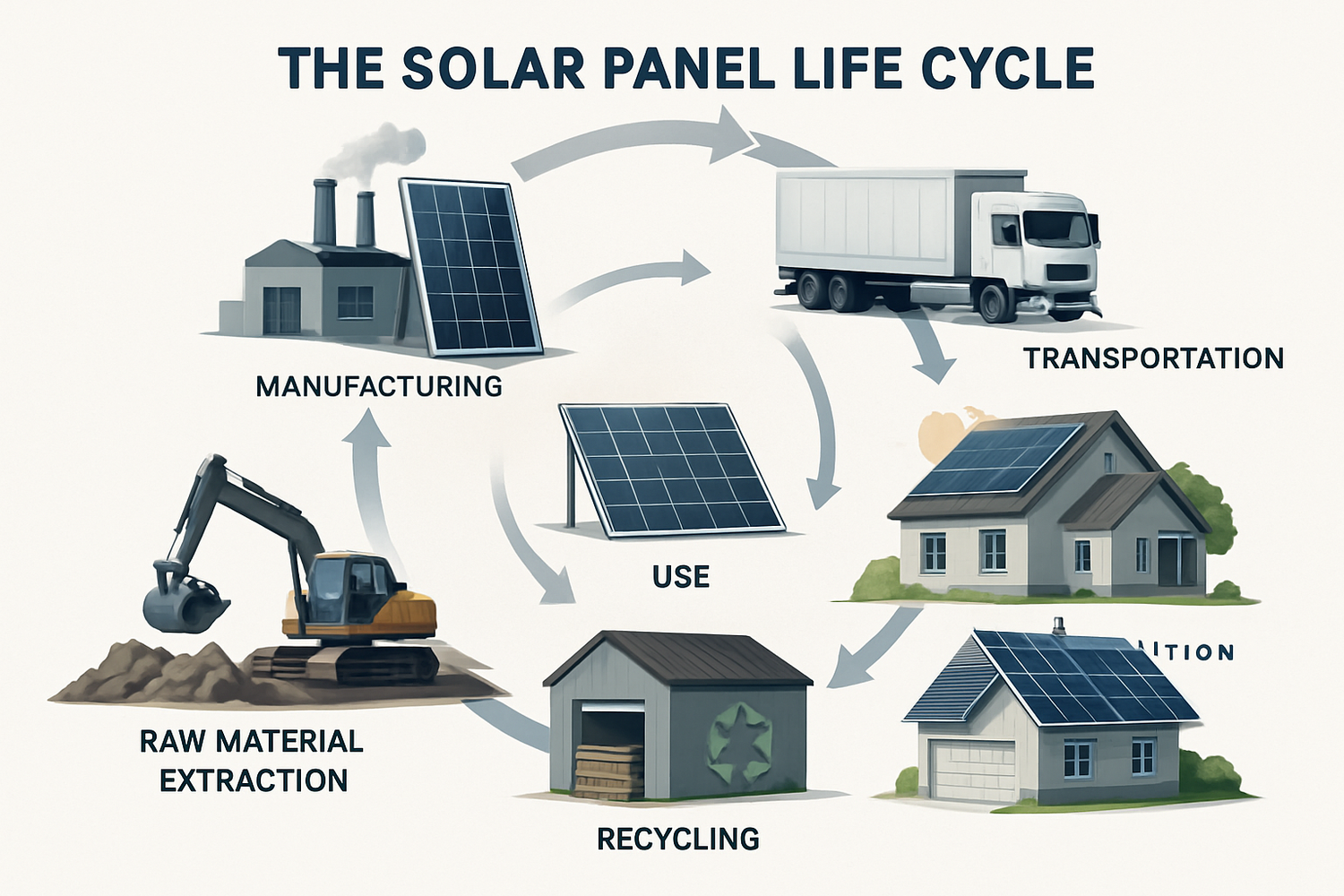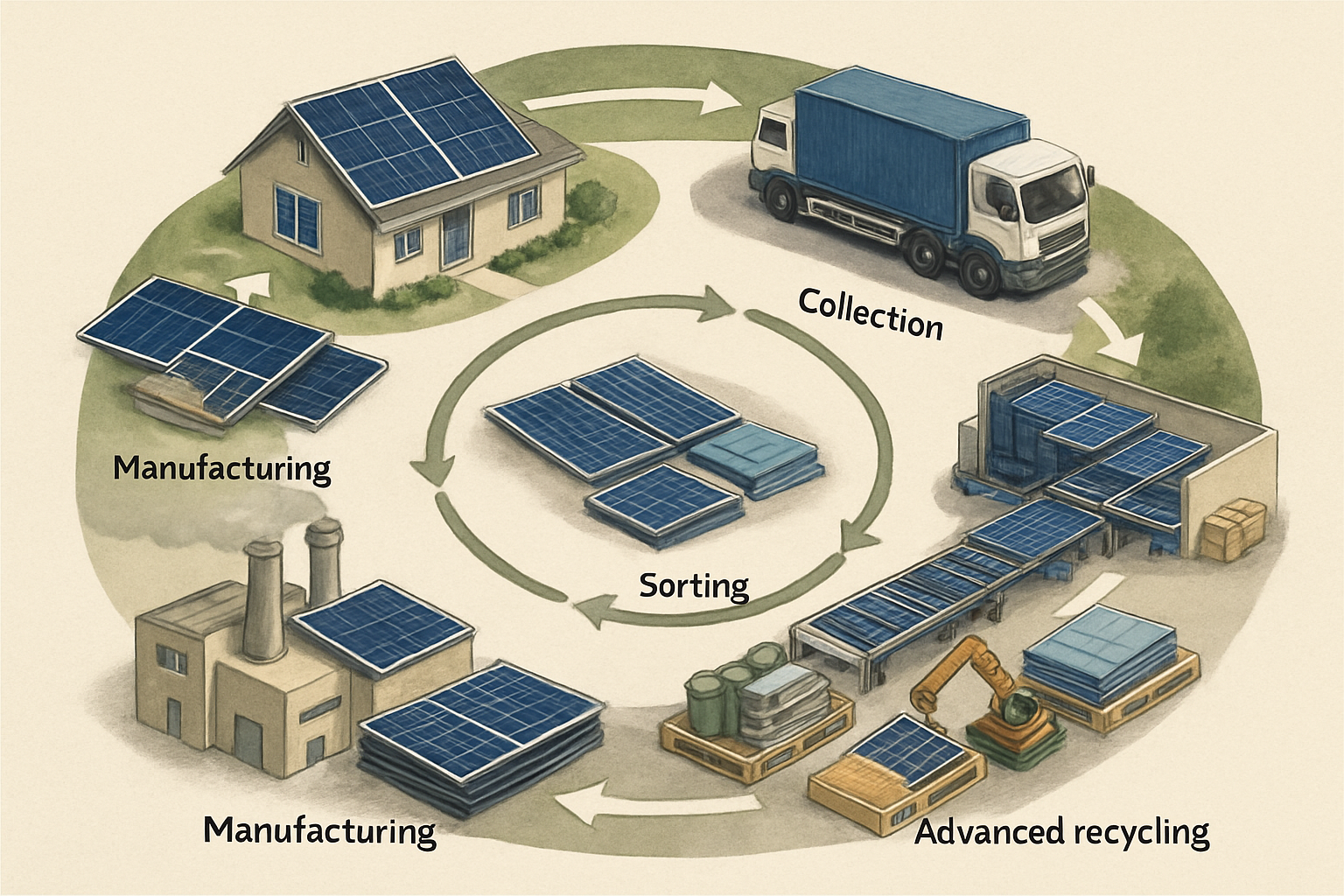Understanding the complete life of a solar panel offers valuable insights into sustainable energy practices. From its creation in a factory to generating electricity and eventually reaching its end-of-life, each stage presents unique considerations. This comprehensive content maps the solar panel's full life cycle, providing practical knowledge for anyone interested in harnessing solar power responsibly.

Manufacturing: From Raw Materials to Finished Product
The life of a solar panel begins with meticulous manufacturing, transforming raw materials into sophisticated energy-producing devices. This process involves several intricate steps to create the photovoltaic (PV) cells and assemble them into a durable module.
Sourcing Materials and Production Processes
The primary material in most solar cells is silicon, derived from quartz. The manufacturing sequence typically starts with silicon purification, where metallurgical-grade silicon is refined into high-purity electronic-grade polysilicon. This polysilicon is then melted and solidified into cylindrical or rectangular ingots through methods like the Czochralski process. These ingots are precisely sliced into thin wafers, which undergo doping to create an electrical field, texturization to enhance light absorption, and the application of anti-reflective coatings and metal contacts. These individual cells are then interconnected, typically using thin metal ribbons, to form strings. Multiple strings are assembled between a glass cover and a backsheet, laminated for environmental protection, framed for structural support, and fitted with a junction box for electrical connections. Rigorous testing and quality assurance checks occur throughout these stages to ensure performance and durability.
Global solar PV manufacturing capacity has seen a significant shift. Over the last decade, it has increasingly moved from regions like Europe, Japan, and the United States to China. China has invested over USD 50 billion in new PV supply capacity since 2011, which is ten times more than Europe. Today, China’s share in all manufacturing stages of solar panels, including polysilicon, ingots, wafers, cells, and modules, exceeds 80%.
Energy Consumption and Environmental Impact
Manufacturing solar panels requires energy. Electricity provides approximately 80% of the total energy used in solar PV manufacturing, with the majority consumed during the production of polysilicon, ingots, and wafers due to their high heat requirements. A significant portion of this electricity, over 60%, is currently powered by fossil fuels, primarily coal, largely because manufacturing is concentrated in China. However, solar panels offer a rapid energy payback. They typically need to operate for only 4 to 8 months to offset the energy consumed during their manufacturing. Some analyses suggest energy payback periods can range from 1 to 4 years, depending on the specific technology.
Installation and Operation: Powering Your Property
Once manufactured, solar panels embark on their mission to convert sunlight into usable electricity. This stage involves careful installation and ongoing performance management.
System Design and Deployment
Successful solar deployment begins with thorough planning. This includes assessing your property's energy needs, evaluating sun exposure, and designing a system that maximizes energy capture. Installation involves securely mounting the panels, typically on rooftops or ground arrays, followed by intricate wiring to connect them to a solar inverter. The inverter converts the direct current (DC) electricity generated by the panels into alternating current (AC) electricity, suitable for household use or feeding into the grid. For enhanced energy independence, many systems integrate energy storage solutions, such as high-performance lithium iron phosphate (LiFePO4) batteries and hybrid inverters, which manage power flow between panels, batteries, and the grid. Off-grid solar solutions, combining panels, batteries, and inverters, offer complete autonomy for homes, farms, or remote cabins.
Performance and Maintenance
Solar panels are designed for longevity and consistent performance. Most modern solar panels have an expected operational lifespan of 25 to 30 years, with some monocrystalline panels potentially lasting 30 to 40 years. During this period, panels gradually degrade, typically losing 0.5% to 0.8% of their efficiency each year. This means that after 25 years, a panel might still produce around 85% of its original output. Regular monitoring helps track performance, ensuring your system operates efficiently. Maintenance usually involves occasional cleaning to remove dirt or debris that could obstruct sunlight, along with periodic checks of electrical connections and components.
The financial benefits of solar energy often become apparent within a few years. In the United States, the average payback period for solar panels typically ranges from 6 to 10 years. For example, EnergySage reported an average payback period of about 7.1 years for their solar shoppers with current incentives.
End-of-Life Management: Recycling and Responsible Disposal
As solar panels approach the end of their useful life, responsible management becomes paramount. This stage focuses on minimizing environmental impact and recovering valuable resources.
Decommissioning and Collection
When a solar panel system reaches the end of its operational lifespan, or if it is decommissioned early for upgrades, careful removal is essential. This involves safely disconnecting the panels and transporting them to appropriate facilities. Establishing efficient collection and logistics infrastructure is a key challenge, particularly given the widespread distribution of solar installations.
Recycling Processes and Resource Recovery
Solar panels contain valuable materials such as glass, aluminum, silicon, copper, and silver. Glass constitutes about 75% of a panel's weight, while aluminum typically makes up the frame. Recycling processes aim to recover these components. For silicon-based panels, this often starts with disassembling the aluminum frame and junction box. The remaining materials are then treated, sometimes thermally, to separate the glass from the encapsulated cells. Specialized processes can then recover high-purity silicon, silver, and other metals. Some advanced recycling technologies boast material recovery rates of up to 98% for key components like silicon, silver, glass, and aluminum. Recovered materials can then re-enter the manufacturing supply chain, supporting a circular economy. For instance, recycled aluminum saves approximately 95% of the energy compared to producing new aluminum from raw ore.
According to the International Renewable Energy Agency (IRENA), recycling could recover over 90% of materials in solar panels, significantly reducing demand for new raw materials. The cumulative value of recoverable raw materials from end-of-life panels globally could reach about USD 450 million by 2030, equivalent to the cost of raw materials for producing approximately 60 million new panels.
Challenges and Future Outlook
Despite the clear benefits, solar panel recycling faces several challenges. The economic viability remains a significant barrier; current processing costs can range from $20 to $30 per panel, while the value of recovered materials might only be $3 to $8 per panel. This disparity often makes landfilling a cheaper option, leading to about 90% of end-of-life panels ending up in landfills. Material separation is complex due to the layers of glass, silicon, and polymers bonded together, often requiring high temperatures to break down adhesives. Additionally, some panels contain hazardous materials like lead and cadmium, necessitating special handling to prevent environmental contamination if not properly disposed of.
Policy frameworks and standardized collection systems are crucial for advancing recycling efforts. Europe is currently the only jurisdiction with a strong regulatory framework for PV recycling. Re-use of functional, early-retired modules presents another valuable option, creating employment and extending product life, but requires careful consideration of environmental risks if secondary recycling is not guaranteed.
The Path Forward for Sustainable Solar
Mapping the solar panel's full life cycle reveals both the immense potential and the critical responsibilities associated with solar energy. From the initial investment in manufacturing to the long-term commitment of operation and the imperative of responsible end-of-life management, each phase influences the overall sustainability of solar power. Embracing robust recycling infrastructure, promoting re-use, and developing advanced material recovery techniques are vital steps. As a company dedicated to reliable and scalable energy solutions, we focus on providing high-performance lithium batteries and integrated energy storage systems that complement solar installations, ensuring you achieve true energy independence with minimal environmental footprint. By gaining insights into and actively participating in every stage of the solar panel's life, you contribute to a cleaner, more sustainable energy future.
Frequently Asked Questions (FAQ)
How long do solar panels typically last?
Most solar panels have a useful operational lifespan of 25 to 30 years. High-quality monocrystalline panels can sometimes last even longer, up to 30-40 years, though their efficiency will gradually decline over time.
What materials are in a solar panel?
Solar panels consist of several materials, including glass (around 75% of the weight), an aluminum frame, silicon cells, copper wiring, and polymer layers for encapsulation. They may also contain small amounts of silver, lead, and cadmium.
Is solar panel recycling economically viable?
Currently, the economics of solar panel recycling present challenges. The cost to process panels often exceeds the market value of the recovered materials, leading many panels to landfills. However, advancements in recycling technology and supportive policies are working to improve economic viability and resource recovery.
How does manufacturing impact the environment?
Solar panel manufacturing is energy-intensive, particularly in the production of polysilicon, ingots, and wafers. A significant portion of this energy currently comes from fossil fuels. However, solar panels quickly offset this initial energy investment, typically within 4 to 8 months of operation, providing decades of clean energy.





Leave a comment
All comments are moderated before being published.
This site is protected by hCaptcha and the hCaptcha Privacy Policy and Terms of Service apply.